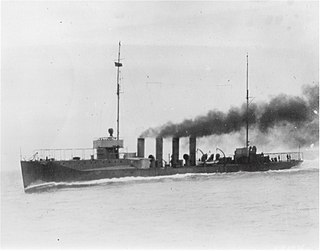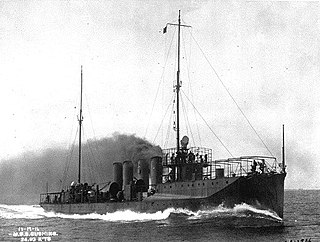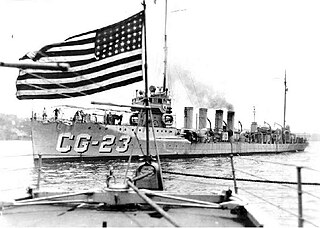
The first USS Chauncey was a Bainbridge-class destroyer, also referred to as a "Torpedo-boat destroyer", in the United States Navy named for Commodore Isaac Chauncey. She was launched in 1901 and sunk in 1917.
USS Allen (DD-66) was a Sampson-class destroyer of the United States Navy launched in 1916. She was the second Navy ship named for Lieutenant William Henry Allen (1784–1813), a naval officer during the War of 1812. She was the longest-serving destroyer on the Naval Vessel Register when she was sold in 1946 and was one of the few ships in the US Navy during World War II which was completed during World War I.

The first ship named in honor of Rear Admiral Aaron Ward, USS Aaron Ward (DD-132) was a Wickes-class destroyer in service with the United States Navy. In 1940, she was transferred to the Royal Navy and renamed HMS Castleton.

The first USS Abbot (DD-184) was a Wickes-class destroyer in the service of the United States Navy until traded to Britain at the beginning of World War II. She served in the Royal Navy as HMS Charlestown (I21), a Town-class destroyer.

The O'Brien class of destroyers was a class of six ships designed by and built for the United States Navy shortly before the United States entered World War I. The O'Brien class was the third of five classes of destroyers that were known as the "thousand tonners", because they were the first U.S. destroyers over 1,000 long tons (1,016 t) displacement.

USS O'Brien was the lead ship of O'Brien-class destroyers built for the United States Navy prior to the American entry into World War I. The ship was the second US Navy vessel named in honor of Jeremiah O'Brien and his five brothers Gideon, John, William, Dennis, and Joseph who, together on the sloop Unity, captured a British warship during the American Revolutionary War.

USS Nicholson was an O'Brien-class destroyer built for the United States Navy before the American entry into World War I. The ship was the second U.S. Navy vessel named in honor of five members of the Nicholson family who rendered distinguished service in the American Revolutionary War, the War of 1812, and the American Civil War: brothers James, Samuel, and John Nicholson; William Nicholson, son of John; and James W. Nicholson, grandson of Samuel.

USS Cushing was an O'Brien-class destroyer built for the United States Navy prior to the American entry into World War I. The ship was the second U.S. Navy vessel named in honor of William B. Cushing, a U.S. Navy officer best known for sinking the Confederate ironclad warship CSS Albemarle during the American Civil War.

The Tucker class of destroyers was a ship class of six ships designed by and built for the United States Navy shortly before the United States entered World War I. The Tucker class was the fourth of five classes of destroyers that were known as the "thousand tonners", because they were the first U.S. destroyers over 1,000 long tons (1,016 t) displacement.

USS Porter was a Tucker-class destroyer built for the United States Navy prior to the American entry into World War I. The ship was the second U.S. Navy vessel named in honor of both David Porter and his son David Dixon Porter.







